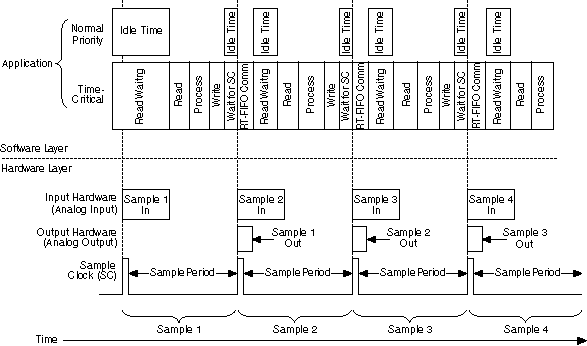Hardware-Timed Simultaneously Updated I/O with Data Exchanges between Time-Critical and Non-Time-Critical Loops
Requirement
The I/O needs to be hardware-timed. All output values need to simultaneously update at the arrival of the sample clock edge. Data needs to be exchanged between a time-critical loop and lower-priority processes.
Solution
- Use the Wait For Next Sample Clock function/VI to verify that a new sample clock edge has not yet occurred.
- Place the communication code (usually real-time FIFOs in LabVIEW or a thread-safe queue in LabWindows/CVI) after the Wait For Next Sample Clock function/VI.
Advantages
- The current iteration's output samples are guaranteed to be aligned with the next iteration's input samples.
- NI-DAQmx returns an error if the Wait For Next Sample Clock function/VI does not start before the next sample clock edge occurs.
- I/O jitter is confined to the jitter of the hardware clock, which is on the order of a few nanoseconds.
- Hardware-timed counter input operations have no conversion period similar to that of multiplexed analog input. Therefore, you can place the real-time FIFO, or the thread-safe queue, anywhere within the loop.
Restrictions
Read, process, and write operations are confined to the amount of time available between the moment the device starts acquiring data and the moment the next sample clock edge arrives.
Sample Application
An example of this kind of application is an analog control loop that reads samples from a specific number of analog input channels, processes the data using a control algorithm (such as PID), and writes the new control values to the analog output channels. The application uses a real-time FIFO to stop the control loop based on a Boolean value provided by a lower-priority process. A similar approach can employ the use of real-time FIFOs to vary the PID parameters on the fly, or to transfer acquired and control output values to lower-priority processes for data logging and remote monitoring.
Timing Diagram

Related Topic